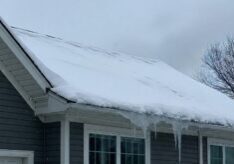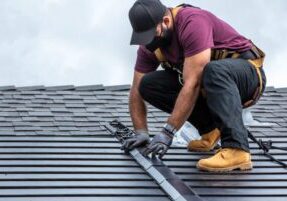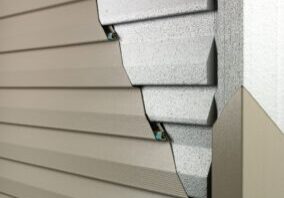The Unpredictable Nature of Hail
In Lansing, MI, we may not frequently experience hail storms, but their occasional spontaneous appearances can cause significant concern for homeowners, particularly regarding the safety and integrity of their roofs. Understanding what hail can do to your roof and how to respond can save you both stress and money.
The Impact of Hail: Size and Duration Matter
Hail can vary dramatically in size and impact, making it crucial to understand the potential damage it can inflict on your roofing.
- Small Hail (Under 1 inch): Resembling the effect of sandblasting your house, small hail may seem less threatening but can gradually wear down your roof, especially over longer durations. While it typically does not break or puncture roofing, this type of hail primarily knocks off the granules from shingle roofs, which protect the asphalt from UV rays and increase longevity, essentially reducing the lifespan of your roof by a few years or more in a single day.
- Medium Hail (1 to 2 inches): This size can start to break shingles and cause visible dents or cracks. It can compromise the water resistance of your roof, leading to leaks if not addressed promptly.
- Large Hail (Over 2 inches): The damage from large hail can be immediately severe. It can puncture your roof, leading to leaks or even structural damage in extreme cases. Thankfully, hail this size is quite rare in our area.
- Duration of the Storm: The longer a hail storm lasts, the more damage it can potentially cause. This is particularly true for small hail, which can effectively strip the protective granule layer off your roof.

Do I Need a Roof Right Now?
Most of the time, hail doesn’t actually cause much damage. Even if heavy hail occurs, it passes through in swaths—with the center experiencing large hail and the outskirts seeing smaller hail with minimal damage. I’ve observed damage on one side of a street and no damage on the other. Only when hail reaches golf ball size or larger do we see a more immediate need; and trust me, if you have hail that size, you will know your roof needs help because there will be damage all around your home. So even if you have repairable damage, it’s often okay to take your time and make sure to find the right contractor that you are comfortable with.
Assessing the Damage
After a hail storm, it’s important to determine the severity of the damage. We don’t recommend climbing on your roof—leave that to a professional roofer. Please stay safe. There are other ways from the ground to see if you should call for help.
Ground Inspection: Look for signs of damage around the house such as dented or cracked siding, damaged screens, and, in cases of large hail, sometimes broken windows.
Professional Assessment: Seek a trusted, certified local contractor to assess your roof. Beware of storm-chasing groups that appear suddenly after severe weather, often using high-pressure sales tactics or promising benefits they can’t guarantee. Local contractors are more likely to provide reliable service and will be available to help if any issues arise with your roof in the future.

Insurance and Repairs: Navigating the Aftermath
If you or your roofing contractor suspect your roof has been damaged by hail, here are your next steps:
Contact Your Insurance Company: Notify them as soon as possible. Most policies cover hail damage, and they will send a representative to assess the extent of the damage.
Understand Your Policy: Know what your insurance covers and understand the process; your agent can help with this. This knowledge will help you ensure that all necessary repairs are covered without unexpected out-of-pocket expenses.
Choose the Right Contractor: If repairs are needed, choose a contractor with a solid reputation in your community.
Finding the Right Contractor:
- Stay Local: When all the work is done, you want to know that they won’t just skip town and leave you high and dry in the future.
- Check with Your Friends and Neighbors: Use Facebook, Google, and NextDoor to find reputable services.
- Ensure They are Licensed and Insured: Don’t be afraid to ask for this documentation; reputable contractors will gladly provide it.
Being Prepared is Key
While hail storms in Lansing, MI, may be infrequent, knowing how to respond when they occur is crucial. By understanding the potential damage, utilizing local resources for assessments and repairs, and effectively navigating insurance claims, you can protect your home and peace of mind. Remember, the right preparation and response can turn a potentially disastrous hail storm into a manageable inconvenience.
Looking for something?
How can we help you?
Ready to find out more?
Drop us a line today for a free quote!








